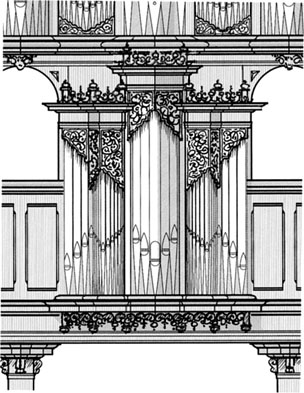

Acting on advice from Dr. Graham Elliott, a former organist at Abergavenny and of Chelmsford Cathedral, now working in Washington DC, it was decided that the organ should be reconstructed on a new gallery in the south transept. Here it would be closer to the congregation and better able to lead worship, as well being available for concerts and other events. It would have a new case, designed as a beautiful structure in its own right to enhance the architecture of this magnificent mediaeval building.
The old organ appeared to be Victorian, dating from 1881. On close inspection it has been found to contain a large number of much earlier pipes. Research has shown that these pipes survive from an organ that once stood in the Lord Mayorºs Chapel in Bristol and was sold to Abergavenny in 1830. These older pipes date from about 1745; the name of the maker is not known. This valuable historic material will be carefully restored to its original function and pitch, and will eventually be in use again at the heart of the organ.
The reconstructed organ will have three manuals and pedals, and attached keyboards in the new gallery from where the organist will have full command of the instrument and the building. The scheme for the organ is similar to that of the old instrument, with resources available for the accompaniment of worship in all its variety. In addition a few new stops will greatly enhance the organºs ability to lead congregational singing and will make it able to perform a wider range of solo and concert repertoire than before. Though some of the pipes will be retained from the old organ, the mechanical parts of the instrument will be entirely new.
The Priory Development Trust has assembled a unique team of specialist craftsmen to carry out the project. In addition to its own architect Michael Bartosch, the Priory has asked the noted organ historian, author and designer Stephen Bicknell to supervise the detail of the scheme and design the organ case and gallery. The organ building work will be entrusted to William Drake of Buckfastleigh in Devon. Drake and his small hand-picked team have done notable work at Lulworth Castle Chapel, Jesus College Oxford, Buckingham Palace and the Palace of Westminster. The gallery and case will be made of quarter-sawn oak by Pennyºs Mill of Great Bedwyn in Wiltshire, under the personal supervision of Rosemary Wakeford. The extensive carved decoration on the front of the organ case will be made, by hand, by the husband-and-wife team of Keith and Shirley Mallinson in Wallingford, Oxfordshire. The consulting engineer is Ian Ceney of Hancock, Wheeldon and Ascough, Solihull.
These specialists have been charged by the Priory with the creation of a unique and lasting musical instrument of superlative quality. We firmly believe that such an organ will enhance this beautiful building and will lead its worship for many generations to come, joining those great organs round the world that have survived from hundreds of years ago. It will also revitalise the cultural life of Abergavenny and the region. It is exceptionally rare in these days of new technology for a fine pipe organ to be made according to ancient craft tradition, and the commissioning of this wonderful instrument, expected to be complete in 2004, will be an event of lasting importance in Wales and beyond.
| HOME IN MEMORIAM |
PORTFOLIO THE HISTORY OF THE ENGLISH ORGAN OTHER PUBLICATIONS |
ESSAYS LINKS |